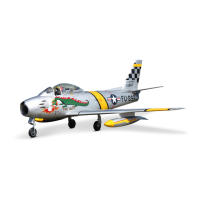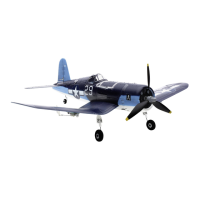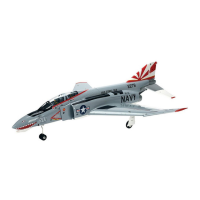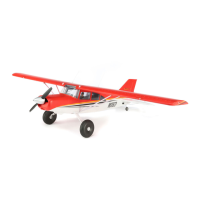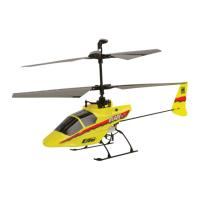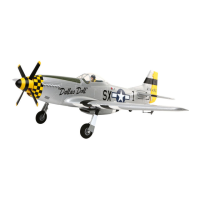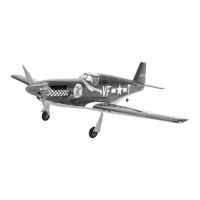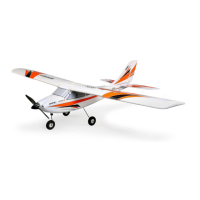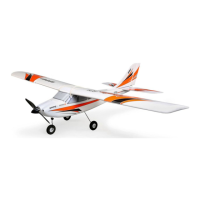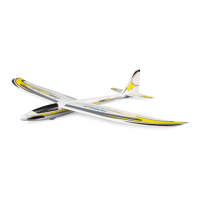Do you have a question about the E-FLITE Mini Funtana and is the answer not in the manual?
Lists specific radio systems, servos, and accessories required for operation.
Details the necessary Li-Po battery and speed control specifications.
Lists the motor, gearbox, and propeller components included and compatible.
Lists necessary tools, adhesives, and other materials for assembly.
Lists optional components that can be purchased for customization.
Instructions for initial inspection of kit parts for damage or missing items.
Guidance on how to effectively navigate and follow the assembly instructions.
Advice on choosing the appropriate motor for optimal performance and duration.
Crucial safety notice regarding the operation of RC aircraft.
Lists major aircraft components and their corresponding part numbers.
Lists smaller hardware, accessories, and miscellaneous parts.
Assembling the wheel with screws and nuts for the landing gear.
Attaching the assembled wheel and nut into the wheel pant.
Repeating the wheel assembly and fitting process for the second wheel.
Drilling pilot holes in the tail for the tail skid attachment.
Securing the tail skid into its designated position using adhesive.
Fastening the main landing gear assembly to the fuselage.
Aligning the wheel pants parallel to the work surface.
Fastening the wheel pants to the landing gear using screws.
Drilling holes in the wing for the CA hinges to ensure secure bonding.
Placing the CA hinges into the prepared slots in the wing.
Applying thin CA adhesive to each hinge to bond the aileron.
Gently pulling the aileron to ensure the hinges are securely attached.
Moving the aileron to ensure smooth movement and proper hinge action.
Repeating the hinging process for the opposite aileron.
Installing grommets and brass eyelets on the servo and attaching extensions.
Routing the servo lead and extension through the wing opening.
Mounting the aileron servo securely within the wing structure.
Modifying the control horn's center hole to fit the pushrod wire.
Repeating the servo and linkage installation for the second wing panel.
Gluing the control horn onto the aileron surface.
Connecting the micro control connector to the servo arm.
Centering the servo arm and securing the pushrod wire.
Inserting the wing tube into the designated slot on one wing panel.
Attaching the first wing panel, with the tube, to the fuselage.
Securing both wing panels to the fuselage using screws and washers.
Placing the stabilizer into the aft slot of the fuselage.
Measuring distances to ensure the stabilizer is centered and parallel.
Verifying that the wing and stabilizer are parallel when viewed from the rear.
Marking the stabilizer's position by tracing the fuselage outline.
Carefully cutting the covering along the traced lines for hinging.
Hinging the elevator to the stabilizer using the same method as ailerons.
Wicking thin CA into the joint to permanently attach the stabilizer.
Placing the fin on the fuselage and tracing its outline.
Removing the covering from the bottom section of the fin.
Adjusting the fin's position and sanding for proper alignment.
Attaching the fin to the fuselage using thin CA adhesive.
Cutting a slot in the fuselage for the lower rudder hinge.
Hinging the rudder to the fin using the standard CA hinge procedure.
Attaching any necessary motor adapters or accessories to the motor.
Mounting the brushless motor securely onto the gearbox.
Gluing the motor support stick into the front formers of the fuselage.
Sliding the gearbox onto the support and trial fitting the cowl.
Mounting the elevator servo and attaching servo extensions.
Modifying the control horn's center hole for the elevator pushrod.
Gluing the elevator control horn to the elevator surface.
Centering the elevator servo and securing the pushrod.
Repeating the servo and linkage installation for the rudder.
Mounting the light ply receiver tray inside the fuselage.
Attaching the Electronic Speed Controller (ESC) to the fuselage side.
Securing the flight battery in the fuselage for proper Center of Gravity.
Placing wax paper between the canopy hatch and fuselage for protection.
Aligning the canopy and tracing its outline onto the hatch.
Lightly sanding the contact edges of the canopy and hatch for better adhesion.
Applying canopy glue to attach the canopy to the hatch.
Sliding the cowl onto the fuselage and checking propeller clearance.
Mounting the propeller onto the motor shaft using a washer and lock nut.
Pressing the spinner into its final position on the gearbox shaft.
Verifying the rudder servo moves correctly in response to the transmitter.
Checking that the elevator servo moves correctly with the transmitter stick.
Adjusting pushrod positions to achieve specified control surface throws.
Testing the radio transmitter's range by walking away from the aircraft.
Confirming that all control surfaces move in the correct direction.
Ensuring that the transmitter batteries are fully charged before flight.
General safety guidelines for operating model aircraft.
Specific safety regulations pertaining to radio control operation.

